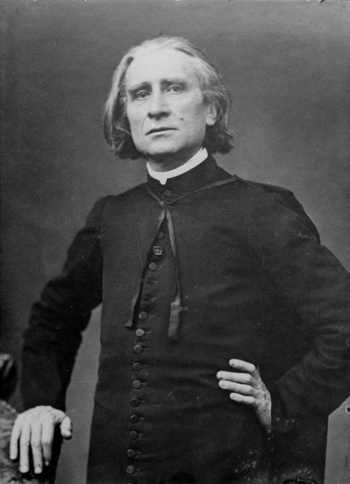 |
| Franz Liszt (Photo credit: Wikipedia) |
Franz Liszt was born in 1811 in the Kingdom of Hungary, which was then a part of the Hapsburg Empire. His nationality is often disputed since many records were destroyed by the Ottoman Turks. Usually, he is claimed as either Hungarian or German, though a small group recognizes him as a Slovak. Adding to the debate, his musical character is often described as French.
His father had dreams of being a musician, and he studied piano, violin, and guitar while attending university. Because of his poverty, he had to give up his music lessons and was employed by Prince Nikolaus II Esterhazy. On several occasions he sat in with an orchestra on the second cello, keeping his musical love alive.
Liszt's father claimed that by the age of nine the boy had played through all of the works of Bach, Beethoven, Mozart, and others. He was forced to buy over eight thousand pages of new music by the masters so that young Franz could keep playing. In 1820 he played to an elite group of socialites who offered to buy his education abroad, but it took two more years before the prince would consider a leave of absence for his father.
Franz's early lessons in Vienna were hard for him because his instructor forced him to learn proper fingerings. Liszt attempted to outsmart his teacher by telling his father the teacher was trying to show him illogical fingerings. Lessons continued after Liszt's father realized his son's trickery.
Early performances in Vienna established him as a child prodigy, but tragedy soon struck. His father's sudden death and a failed love affair in France threw him into depression. He didn't play or compose for a few years until revolution took over Paris.
Travels and tours throughout Europe allowed Liszt to meet many noted composers and artists of the day. He had many love affairs and a few children as well. Eventually, he ended up in Weimar, where he wrote the Liebestraum.
The Liebestraum is a delicate piece of music written in his own romantic style. Playing it requires dexterity in both hands and a grasp of sensitivity that takes time to master. No classical pianist's repertoire is complete without the Liebestraum.
Liebestraum is German for "dreams of love." The name Liebestraum is often used to refer to the third of the pieces, though it is actually the name of the entire set. The three parts are based on poems by Ludwig Uhland and Ferdinand Freiligrath. Each poem describes a different type of love: exalted love, erotic love, and mature love.
The third movement of the Liebestraum is the best known. It is also a reliable test of a pianist's ability. At the time, a version of the Liebestraum for piano and high voice and another for piano two-hands was published.
Throughout his varied life, Franz Liszt created mesmerizing works, including the Faust Symphony and the Liebestraum. He is often called the greatest pianist who ever lived, and the Liebestraum is a great argument in his favor.
Duane Shinn is the author of the popular DVD home study course on playing piano titled Crash Course In Exciting Piano Playing! Article Source: EzineArticles |

